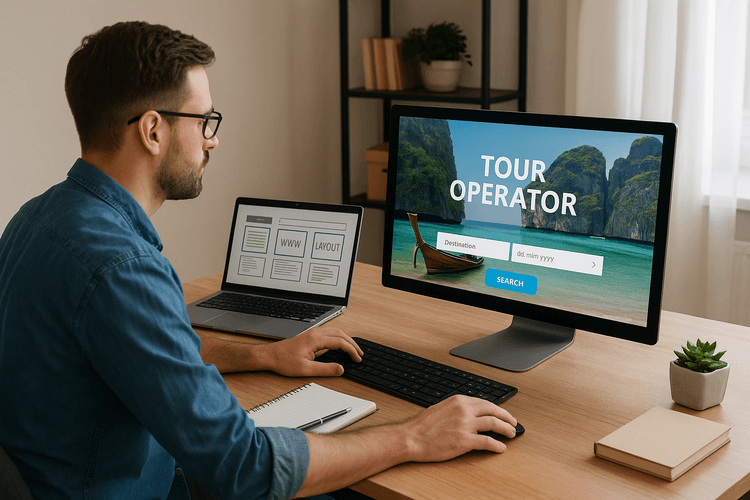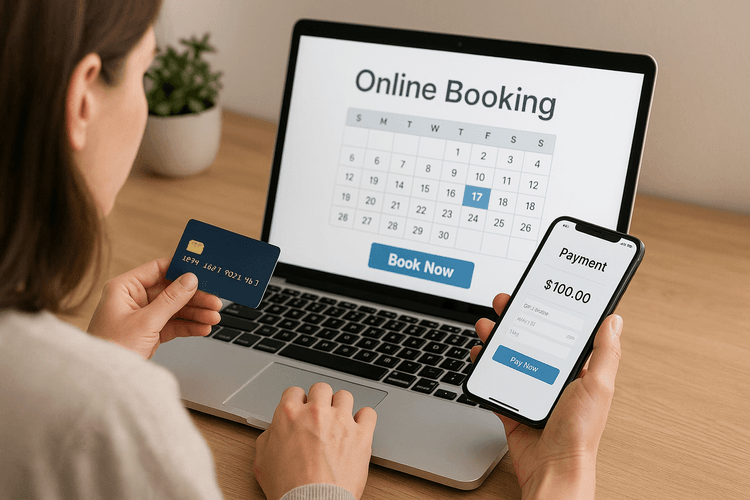
Online tour operators have become an integral part of the tourism industry. These companies handle bookings and planning for trips, hotels, flights, cruises, and much more.
Thanks to online tour operators, it is possible to organize one's own trip with just a few clicks and with a customizable budget. What makes these websites so useful is their ability to provide holiday packages that include everything needed for a complete travel experience.
What is an online tour operator?
An online tour operator is a company that deals with the planning and organizing of trips through its website. Typically, these sites offer complete vacation packages, including flights, hotels, and tourist activities. Some online tour operators also offer services such as car rental or booking excursions.
One of the main advantages of online tour operators over traditional travel agencies is the ability to customize your own holiday package by choosing from numerous options. Moreover, the Please note that I stopped at "Moreover, the" because you didn't provide the continuation of the sentence. If you want me to translate further, please provide the rest of the text. Online tour operators often offer more affordable prices thanks to commercial agreements with external suppliers.
How to create a website for a tour operator
To create a website for a tour operator, there are several platforms that can help achieve a professional result quickly. Framework360 is one of these: the complete cloud digital marketing platform that helps you create and manage your own website independently and conduct digital marketing.
Once registered, you will be able to use the theme generator to create your own website with artificial intelligence and customize it using the navigation menu on the left. Furthermore, Framework360 also offers marketing features such as sending newsletters and creating automated campaigns.
- Step 1: Register on the Framework360 platform
- Step 2: Use the theme generator to create your website
- Step 3: Customize your website using the available options in the navigation menu
- Step 4: Use the marketing features offered by Framework360 to increase the visibility of your online tour operator
In summary, online tour operators are an important part of the tourism industry and offer many opportunities for those who wish to organize tailor-made trips at affordable prices. Creating a website for an tour operator may seem complicated, but with the right platforms like Framework360, it can be done simply and efficiently!
Identify your goals and target audience

Before starting to create the website, it is important to identify your goals and target audience. This will allow you to create a website that is effective in achieving your set goals and capable of meeting the needs of your audience.
Objectives
The objectives can vary from tour operator to tour operator, but in general some common goals can be identified:
- Increase online bookings;
- Improve the company's visibility;
- Build loyalty among existing customers;
- Provide detailed information about the products offered.
It is important to define specific objectives for your own tour operator and always keep these objectives in mind during the website design phase.
Target audience
The target audience can also vary greatly depending on the type of tour operator. For example, if it is a tour operator specialized in trips for families with children, the target audience will primarily consist of parents with young children.
To identify your target audience, you can make some considerations:
- Age and gender;
- Interests and passions;
- Economic situation;
- Travel needs.
Knowing your target audience is essential for creating a website that can effectively communicate with them. For example, if the target audience consists of elderly people, it will be important to avoid using too small fonts or colors with low contrast.
In summary, identifying your goals and target audience represents the foundation for creating an effective website capable of meeting the needs of the tour operator and its customers.
Choosing a domain name and hosting

The choice of domain name is an important step in creating your tour operator's website. The domain name is the web address that your visitors will use to access your site, for example www.mytouroperator.com.
The domain name should be short, easy to remember, and relevant to your business. If possible, choose a domain name that includes the main keywords of your business, so as to make it easier for search engines like Google to find your website.
After choosing your domain name, you need to decide which hosting to use to host your website. Hosting is the service that allows you to publish your website online and make it visible to visitors.
There are several hosting options to choose from depending on your needs. For example, if you expect high traffic on your website or want more features, you might opt for a dedicated hosting. However, if you are new to creating websites or have a limited budget, you might consider using a shared hosting.
Example:- Your tour operator is called "World Travels" and you would like to use "worldtravels.it" as the domain name.
- You decide to use shared hosting to host your website since you have a limited budget.
Remember that choosing the domain name and hosting is just one of the first steps in creating the website for your tour operator. Continue following our advice to ensure you have an effective and professional website.
Creating the website structure

After registering your account on Framework360 and setting up the environment for your website, it's time to create the structure of your site.
The first thing to do is choose a theme from those available in the theme generator. The theme generator uses artificial intelligence to create a customized design based on your preferences. Select the theme that best suits your business and corporate image.
At this point, you can begin to customize the structure of your website through the navigation menu on the left. In this section, you can add pages, change the general settings of the site, manage plugins, and much more.
Adding pages
To add a new page to your website, simply click on the "Pages" icon in the navigation menu on the left and select "Add New Page". You will then be able to enter the title of the page and its associated content.
You can choose from different types of pages: home page, contacts, about us, services, and so on. Insert all the necessary pages to effectively present your business to the site's visitors.
Website style management
In this section, you can modify the styles of your website in a simple and intuitive way. You can select colors, fonts, and styles for headings, text, and graphic elements.
It is important to maintain a consistent style throughout the website, so as to create a uniform browsing experience for the user. Choose a style that fits your corporate image and that is easily recognizable by the site's visitors.
Plugin management
Plugins are additional tools that you can use to enhance the functionality of your website. Framework360 offers you a wide range of plugins to choose from, such as contact forms, image sliders, photo galleries, and much more.
You can manage plugins from the "Plugins" menu in your website's control panel. Select the most useful plugins for your business and customize them according to your needs.
Create a navigation menu
Creating a navigation menu is essential to allow visitors of your site to easily find the information they are looking for. You can create your own navigation menu from the "Appearance" menu in the "Menus" section.
In this section, you can select which pages to include in the menu and arrange their order. You can also change the style of the menu, such as background color or button style.
Summary
In this section we have seen how to create the structure of your website using Framework360. Remember to choose a theme that fits your corporate image, include all the necessary pages to effectively present your business, and manage styles and plugins to improve user experience.
Don't forget to create a clear and intuitive navigation menu to allow visitors of your website to easily find the information they are looking for.
Writing content for the website

Once the website design is set up, it's important to focus on writing content. The writing must be persuasive and engaging to attract visitors and convince them to book your tours.
Define your market niche
Before starting to write, it's important to define your market niche. What kind of tourism do you specialize in? For example, do you offer tours for families, adventurous trips, or culinary experiences? Once you have defined your niche, you can tailor the tone of your writing to your potential customers.
Write Short and Effective Texts
The visitors of your website don't have time to waste. Write short and effective texts that explain who you are, what you do, and why they should book a tour with you. Use direct and simple sentences that capture the reader's attention. Don't go into too much technical or historical detail.
Highlight the Benefits
Visitors want to know what benefits they will gain by booking a tour with you. Highlight the advantages of your services: time savings, ease in trip organization, authentic experiences, and so on.
Include Photos and Videos
Photos and videos can make a difference in customer choice. Include some on your website to show potential clients what awaits them during the tour. The images should be high quality and showcase authentic experiences.
Leverage Customer Reviews
Customer reviews are an excellent source of trust for potential new clients. Feature them on your website, perhaps in a dedicated testimonials section, or share them on your social media.
Remember: the goal is to sell
The goal of the tour operator's website is to sell your services. Ensure that every page on the website is designed to lead visitors to take action: book a tour, contact you for more information, or subscribe to your newsletter.
- Write short and effective texts;
- Highlight the benefits;
- Include photos and videos;
- Use customer reviews;
- Remember: the goal is to sell.
Seo optimization to increase website visibility on search engines

Once we have created our website, it's important that it is visible on search engines like Google. SEO optimization helps us to position our site among the top search results when users search for keywords related to our business.
Here are some tips to optimize our site:
1. Choice of keywords
Keywords are the phrases or words that users type into search engines to find specific content. It's crucial to choose the right keywords for our business and include them in the page title, H1 and H2 tags, meta description, and within the page text.
2. Creating quality content
Search engines value sites that offer original, relevant, and high-quality content to users. Therefore, it is important to create useful and interesting content for our potential customers, incorporating the chosen keywords within it.
3. Use of meta tags
Meta tags are information about the page content that is displayed by search engines when a search is performed. It's important to include a meta description, which should be brief but descriptive, and the page title, which should contain the chosen keywords.
4. Text structuring
It is important to structure the text of the page in a clear and well-organized manner, using H1, H2, and H3 tags to highlight titles and subtitles. Additionally, it is advisable to use bullet points to make lists of information clearer.
5. Image optimization
Images can enhance the user experience on our website, but they must be optimized so as not to slow down the page loading time. It is important to include an alt description that details the content of the image.
6. Link building
Link building involves creating links to our site from other external pages. This practice improves the visibility of our site on search engines and increases the authority of our site in the eyes of users. It is important to create links from reliable and relevant sites to our industry.
7. Performance monitoring
It is essential to monitor the performance of our website through data analysis tools such as Google Analytics. This allows us to evaluate the effectiveness of our SEO strategies and make any necessary adjustments to improve the visibility of our site on search engines.
- Carefully choose keywords
- Aim to create quality content
- Use meta tags
- Structure the page text clearly and well-organized
- Optimize images
- Create links to the site from other external pages
- Constantly monitor the website's performance
By following these tips, we will be able to improve the visibility of our site on search engines and attract more potential customers to our business.
Management of online bookings and payments

For a tour operator, managing bookings and online payments is a crucial aspect for the success of the business. Thanks to Framework360, all this can be managed in a simple and effective way.
Online bookings
The first step is to create a dedicated page for booking the services offered by the tour operator. This page can be easily created using Framework360's page builder.
On the booking page, customers will be able to select the desired services, choose available dates, and enter their personal information. Once the booking process is complete, the customer will receive an email confirmation with all the details of their reservation.
- Create a dedicated booking page using the Framework360 page builder;
- Allow customers to select desired services and available dates;
- Customer's personal data entry;
- Automatic receipt of a confirmation email containing the details of the reservation.
Online payment management
Once the customer has made their reservation, it will be necessary to also manage online payment. Framework360 offers several options for integrating payment systems, including PayPal and Stripe.
To integrate one of these payment systems, simply access the website settings and select the corresponding option. This way, customers will be able to make payments directly on the booking page.
- Integration of payment systems such as PayPal or Stripe;
- Possibility for customers to make payments directly on the booking page.
In summary, thanks to Framework360 it is possible to create a dedicated page for booking the services offered by the tour operator and manage online payments in a simple and effective way. This will allow the tour operator to provide a complete service to their customers, increasing satisfaction and the success of the business.
Framework360 therefore offers a comprehensive solution for managing bookings and online payments for tour operators. Thanks to its ease of use and the ability to customize the platform, every tour operator can create a professional and functional website without any difficulty.Creating a website for a tour operator has never been so easy!You can do it too, you just need a lot of commitment and an excellent marketing and sales platform.
Free trial for 30 days. No credit card required.







